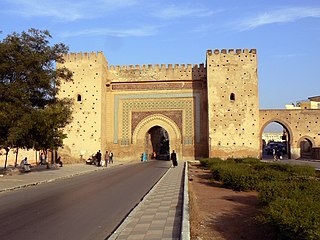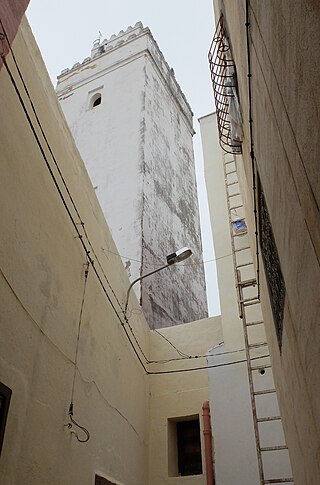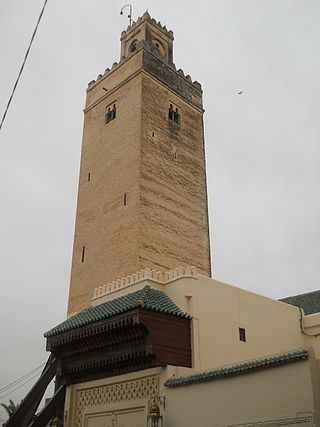
Meknes is one of the four Imperial cities of Morocco, located in northern central Morocco and the sixth largest city by population in the kingdom. Founded in the 11th century by the Almoravids as a military settlement, Meknes became the capital of Morocco during the reign of Sultan Ismail Ibn Sharif (1672–1727), son of the founder of the Alaouite dynasty. Sultan Ismail created a massive imperial palace complex and endowed the city with extensive fortifications and monumental gates. The city recorded a population of 632,079 in the 2014 Moroccan census. It is the seat of Meknès Prefecture and an important economic hub in the region of Fès-Meknès.

Moroccan architecture reflects Morocco's diverse geography and long history, marked by successive waves of settlers through both migration and military conquest. This architectural heritage includes ancient Roman sites, historic Islamic architecture, local vernacular architecture, 20th-century French colonial architecture, and modern architecture.

Chefchaouen is a city in northwest Morocco. It is the chief town of the province of the same name and is noted for its buildings in shades of blue, for which it is nicknamed the "Blue City". It is situated in a mountainous region in northern Morocco, between Tétouan and Ouazzane.

The Kasbah of the Udayas, also spelled Kasbah of the Oudaias or of the Oudayas, is a kasbah (citadel) in Rabat, Morocco. It is located on a hill at the mouth of the Bou Regreg opposite Salé, and adjacent to the Medina quarter of Rabat. It is listed, along with other sites in Rabat, as a UNESCO World Heritage Site.

The Great Mosque of Taza is the most important religious building in the historic medina of Taza, Morocco. Founded in the 12th century by the Almohad caliph Abd al-Mu'min, it is the oldest surviving example of Almohad architecture. It was expanded by the Marinids in the late 13th century and renovated by the 'Alawi sultan al-Rashid in the 17th century.

The Grand Mosque of Tangier is the historic main mosque of Tangier, Morocco, located in the city's old medina. While the design of the current mosque dates from the early 19th century during the Alaouite period, the site has been occupied by a succession of religious buildings since antiquity.

The Bab Berdieyinne Mosque is a mosque in the old city (medina) of Meknes, Morocco, a UNESCO World Heritage Site. The mosque was built in the early 18th century on the orders of Morocco's first female minister, Khnata bent Bakkar, and was constructed of rammed earth. It is named after the nearby city gate.

The Kasbah Mosque, also known as the Moulay al-Yazid Mosque, is a historic mosque in Marrakesh, Morocco. It was originally built by the Almohad ruler Yaqub al-Mansur in 1185–1190 CE. It is located in the Kasbah district, the city's former citadel, near the site of its historic royal palaces. Along with the Kutubiyya Mosque, it is one of the most important historic mosques in Marrakesh.

The Bab Guissa Mosque is a medieval mosque in northern Fes el-Bali, the old city of Fez, Morocco. It is located next to the city gate of the same name, and also features an adjoining madrasa.

The Chrabliyine Mosque is a Marinid-era mosque in Fez, Morocco.

The Ben Salah Mosque or Ben Saleh Mosque is a 14th-century Marinid mosque in the historic medina of Marrakesh, Morocco. It is the only major surviving Marinid-era monument in Marrakesh and is notable for its fine minaret.

The architecture of Fez, Morocco, reflects the wider trends of Moroccan architecture dating from the city's foundation in the late 8th century and up to modern times. The old city (medina) of Fes, consisting of Fes el-Bali and Fes el-Jdid, is notable for being an exceptionally well-preserved medieval North African city and is classified as a UNESCO World Heritage Site. A large number of historic monuments from different periods still exist in it today, including mosques, madrasas, synagogues, hammams (bathhouses), souqs (markets), funduqs (caravanserais), defensive walls, city gates, historic houses, and palaces.

The Grand Mosque of Meknes is the historic main mosque of the old city (medina) of Meknes, Morocco. It is the largest and most important mosque in the old city and one of its oldest monuments.

The Kasbah Mosque is a mosque in Tangier, Morocco, and the main mosque of the historic royal citadel (kasbah) in the old city (medina) of Tangier. It dates to the late 17th century.

The Great Mosque of Fes el-Jdid is the historic main Friday mosque of Fes el-Jdid, the royal city and Marinid-era citadel of Fes, Morocco. It is believed to have been founded in 1276, around the same time that the city itself was founded, making it the oldest mosque in Fes el-Jdid.

The al-Hamra Mosque or Red Mosque is a Marinid-era mosque in Fes, Morocco. It is a local Friday mosque located on the Grande Rue of Fes el-Jdid, the palace-city founded by the Marinid rulers.

The Lalla Aouda Mosque or Mosque of Lalla 'Awda is a large historic mosque in Meknes, Morocco. It was originally the mosque of the Marinid kasbah (citadel) of the city, built in 1276, but was subsequently remodeled into the royal mosque of the Alaouite sultan Moulay Isma'il's imperial palace in the late 17th century.
The Barrima Mosque is a mosque in Marrakesh, Morocco, attached to the Kasbah (citadel) and Royal Palace of the city. It was built in the late 18th century by the Alaouite sultan Muhammad ibn Abdallah.

The Kasbah of Moulay Ismail is a vast palace complex and royal kasbah (citadel) built by the Moroccan sultan Moulay Isma'il ibn Sharif in Meknes, Morocco. It is also known, among other names, as the Imperial City or Palaceof Moulay Ismail, or the Kasbah of Meknes. It was built by Moulay Isma'il over the many decades of his reign between 1672 and 1727, when he made Meknes the capital of Morocco, and received occasional additions under later sultans.

The Grand Mosque in Asilah, Morocco, is the main mosque of the historic royal citadel (kasbah) in the old city (medina) of Asilah. It was built under Moulay Ismail in the late 17th century.




















